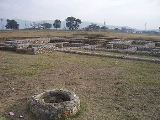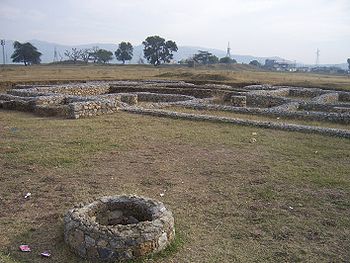
Bhir Mound
Encyclopedia
The Bhir Mound is the oldest of the ruins of Taxila
in the Punjab
province of Pakistan
.

. The work was continued by Sir Mortimer Wheeler
in 1944-1945 and by Dr. Mohammad Sharif in 1966-1967. Further excavations were performed in 1998-2000 by Bahadur Khan and in 2002 by Dr. Ashraf and Mahmud-al-Hassan.
The streets of the city show that they were narrow and the house plans were very irregular. There is little evidence of planning - most of the streets are very haphazard. The houses had no windows to the outside. They opened towards inner courtyards. The courtyard was open and 15 to 20 rooms were arranged around it.
Ambhi, it is recorded, entertained the Greek king here. He surrendered to Alexander and offered him a body of soldiers mounted on elephant
s. In 316 BCE, Chandragupta
of Magadha
, the founder of the Mauryan dynasty, conquered Panjab
. Taxila lost its independence and became a mere provincial capital. Still, the city remained extremely important as centre of administration, education and trade. During the reign of Chandragupta's grandson Ashoka
, Buddhism
became important and the first monks settled in Taxila. Ashoka is said to have resided here as the vice-king of his father. In 184 BCE, the Greeks, who had maintained a kingdom in Bactria
, invaded Gandhara
and Panjab again. From now on, a Greek king resided in Taxila, Demetrius
.
Taxila
Taxila is a Tehsil in the Rawalpindi District of Punjab province of Pakistan. It is an important archaeological site.Taxila is situated about northwest of Islamabad Capital Territory and Rawalpindi in Panjab; just off the Grand Trunk Road...
in the Punjab
Punjab (Pakistan)
Punjab is the most populous province of Pakistan, with approximately 45% of the country's total population. Forming most of the Punjab region, the province is bordered by Kashmir to the north-east, the Indian states of Punjab and Rajasthan to the east, the Pakistani province of Sindh to the...
province of Pakistan
Pakistan
Pakistan , officially the Islamic Republic of Pakistan is a sovereign state in South Asia. It has a coastline along the Arabian Sea and the Gulf of Oman in the south and is bordered by Afghanistan and Iran in the west, India in the east and China in the far northeast. In the north, Tajikistan...
.

Excavation
The ruins of Bhir Mound were excavated from 1913-1925 by Sir John MarshallJohn Marshall
John Marshall was the Chief Justice of the United States whose court opinions helped lay the basis for American constitutional law and made the Supreme Court of the United States a coequal branch of government along with the legislative and executive branches...
. The work was continued by Sir Mortimer Wheeler
Mortimer Wheeler
Brigadier Sir Robert Eric Mortimer Wheeler CH, CIE, MC, FBA, FSA , was one of the best-known British archaeologists of the twentieth century.-Education and career:...
in 1944-1945 and by Dr. Mohammad Sharif in 1966-1967. Further excavations were performed in 1998-2000 by Bahadur Khan and in 2002 by Dr. Ashraf and Mahmud-al-Hassan.
The Ruins
The ruins of the town form an irregular shape measuring around 1 km from north to south and about 600 meters from east to west. The oldest part or layer of these ruins is from the sixth and fifth centuries BC. The second layer is from the fourth century BC and existed at the time of the invasion of Alexander the Great. The third layer is from the time of the Maurya kings of India (third century BC). The fourth and topmost stratum contains the constructions from time after the Mauryan period.The streets of the city show that they were narrow and the house plans were very irregular. There is little evidence of planning - most of the streets are very haphazard. The houses had no windows to the outside. They opened towards inner courtyards. The courtyard was open and 15 to 20 rooms were arranged around it.
History
Darius I conquered Bhir in 518 BCE. However, this assumption is based only upon textual evidence. In 326 BCE, Alexander the Great came and conquered the area. RajaRaja
Raja is an Indian term for a monarch, or princely ruler of the Kshatriya varna...
Ambhi, it is recorded, entertained the Greek king here. He surrendered to Alexander and offered him a body of soldiers mounted on elephant
Elephant
Elephants are large land mammals in two extant genera of the family Elephantidae: Elephas and Loxodonta, with the third genus Mammuthus extinct...
s. In 316 BCE, Chandragupta
Chandragupta Maurya
Chandragupta Maurya , was the founder of the Maurya Empire. Chandragupta succeeded in conquering most of the Indian subcontinent. Chandragupta is considered the first unifier of India and its first genuine emperor...
of Magadha
Magadha
Magadha formed one of the sixteen Mahājanapadas or kingdoms in ancient India. The core of the kingdom was the area of Bihar south of the Ganga; its first capital was Rajagriha then Pataliputra...
, the founder of the Mauryan dynasty, conquered Panjab
Punjab region
The Punjab , also spelled Panjab |water]]s"), is a geographical region straddling the border between Pakistan and India which includes Punjab province in Pakistan and the states of the Punjab, Haryana, Himachal Pradesh, Chandigarh and some northern parts of the National Capital Territory of Delhi...
. Taxila lost its independence and became a mere provincial capital. Still, the city remained extremely important as centre of administration, education and trade. During the reign of Chandragupta's grandson Ashoka
Ashoka
Ashok Maurya or Ashoka , popularly known as Ashoka the Great, was an Indian emperor of the Maurya Dynasty who ruled almost all of the Indian subcontinent from ca. 269 BC to 232 BC. One of India's greatest emperors, Ashoka reigned over most of present-day India after a number of military conquests...
, Buddhism
Buddhism
Buddhism is a religion and philosophy encompassing a variety of traditions, beliefs and practices, largely based on teachings attributed to Siddhartha Gautama, commonly known as the Buddha . The Buddha lived and taught in the northeastern Indian subcontinent some time between the 6th and 4th...
became important and the first monks settled in Taxila. Ashoka is said to have resided here as the vice-king of his father. In 184 BCE, the Greeks, who had maintained a kingdom in Bactria
Bactria
Bactria and also appears in the Zend Avesta as Bukhdi. It is the ancient name of a historical region located between south of the Amu Darya and west of the Indus River...
, invaded Gandhara
Gandhara
Gandhāra , is the name of an ancient kingdom , located in northern Pakistan and eastern Afghanistan. Gandhara was located mainly in the vale of Peshawar, the Potohar plateau and on the Kabul River...
and Panjab again. From now on, a Greek king resided in Taxila, Demetrius
Demetrius
Demetrius, also spelled as Demetrios, Dimitrios, Demitri, and Dimitri , is a male given name.Demetrius and its variations may refer to the following:...
.
See also
- DharmarajikaDharmarajikaThe Dharmarajika is a large Buddhist stupa in the area of Taxila, Pakistan. It is thought that it was established by the Maurya emperor Ashoka in the 3rd century BCE around relics of the Buddha.The stupa is also popularly called as 'Chir Tope.'The site of divided into two parts: the stupa area in...
- Mohra MuraduMohra MuraduMohra Muradu is the place of an ancient buddhistic stupa and monastery near the ruins of Taxila, in the Punjab province of Pakistan. The ancient monastery is located in a valley and offers a beautiful view of the surrounding mountains...
- JaulianJaulianJaulian are the ruins of an ancient buddhistic monastery near Taxila, Punjab , Pakistan.-The Ruins:The ruins at Jaulian date from the fifth century CE and consist of two main parts. These are 1) the main stupa and 2) the monastery and university of Jaulian. The ruins are situated on a mountain top...
- SirkapSirkapSirkap is the name of an archaeological site on the bank opposite to the city of Taxila, Punjab, Pakistan.The city of Sirkap was built by the Greco-Bactrian king Demetrius after he invaded ancient India around 180 BC. Demetrius founded in the northern and northwestern Indian subcontinent an...
- SirsukhSirsukhSirsukh is the name of an archaeological site near the city of Taxila, Punjab, Pakistan.-The City:The city of Sirsukh was founded by the Kushan king Kanishka after 80 CE, and is the last of the great ancient cities of Taxila. The invaders decided to abandon the older city of Sirkap and build a...
- TaxilaTaxilaTaxila is a Tehsil in the Rawalpindi District of Punjab province of Pakistan. It is an important archaeological site.Taxila is situated about northwest of Islamabad Capital Territory and Rawalpindi in Panjab; just off the Grand Trunk Road...

